Page 99 of 422
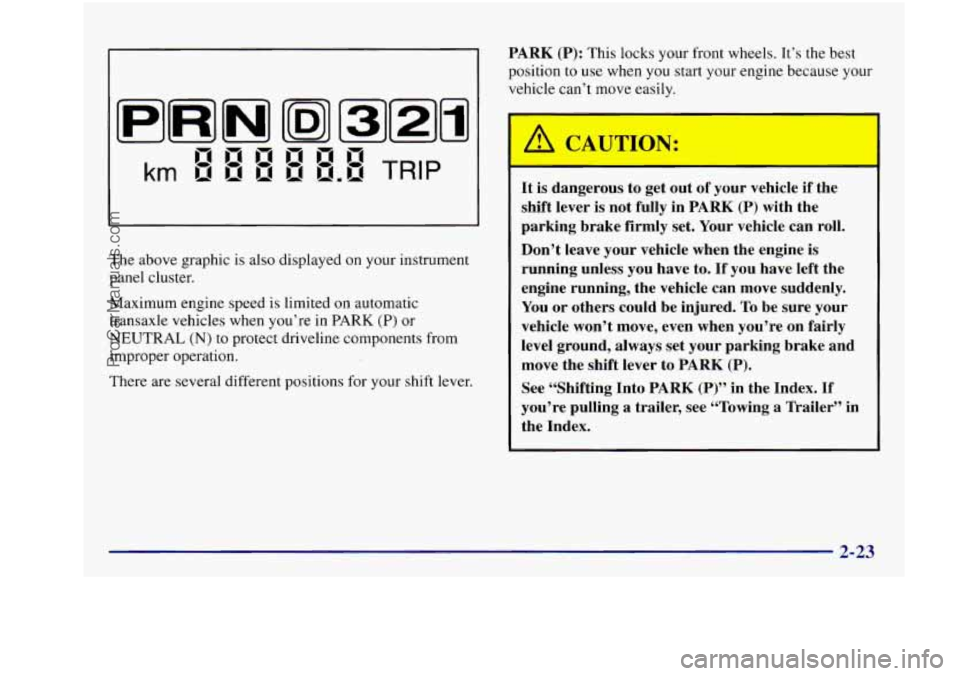
I I PARK (P): This locks your front wheels. It’s the best
I position to use when you start your engine because your
I I vehicle can’t move easilv.
-:
d
B I B I B!I BJ LI ------
km Irr Irr ,,r u ,,r,,,r TRIP
It is dangerous to get out of your vehicle if the
‘I
shift lever is not fully in PARK (P) with the
parking brake firmly set. Your vehicle can roll.
The above graphic is also displayed on your instrument
panel cluster.
Maximum engine speed
is limited on automatic
transaxle vehicles when you’re in PARK (P) or
NEUTRAL
(N) to protect driveline components from
improper operation.
There are several different positions for your shift lever.
Don’t leave your vehicle when the engine is
running unless you have to.
If you have left the
engine running, the vehicle can move suddenly.
You or others could be injured.
To be sure your
vehicle won’t move, even when you’re on fairly
level ground, always set your parking brake and
move the shift
lever to PARK (P).
See “Shifting Into PARK (P)” in the Index. If
you’re pulling a trailer, see “Towing a Trailer’’ in
the Index.
2-23
ProCarManuals.com
Page 103 of 422
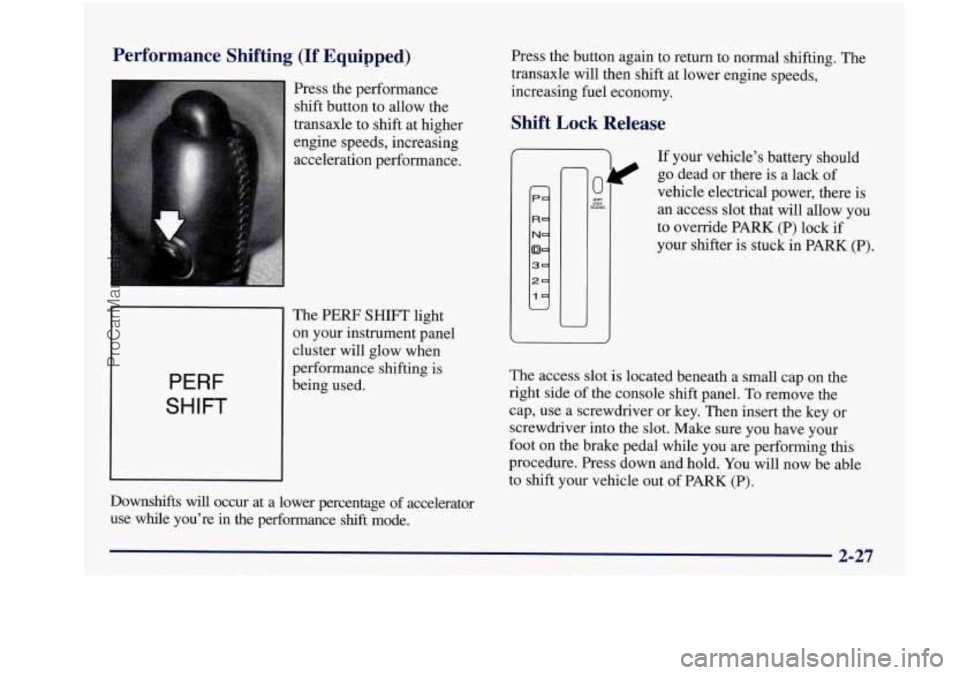
Performance Shifting (If Equipped)
Press the performance shift button to allow the
transaxle
to shift at higher
engine speeds, increasing
acceleration performance.
PERF
SHIFT
The PERF SHIFT light
on your instrument panel
cluster will glow when
performance shifting is
being used.
Downshifts will occur at a lower percentage of accelerator
use while you’re
in the performance shift mode. Press the button again to return to normal shifting. The
transaxle will then shift at lower engine speeds,
increasing
fuel economy.
Shift Lock Release
P
1
If your vehicle’s battery should
vehicle electrical power, there is an access slot that will allow you
to override PARK (P) lock if
your shifter is stuck in PARK
(P).
I( go dead or there is a lack of
The access slot
is located beneath a small cap on the
right side of the console shift panel.
To remove the
cap, use a screwdriver or key. Then insert the key or screwdriver into the slot. Make sure you have your
foot on the brake pedal while you are performing this
procedure. Press down and hold.
You will now be able
to shift your vehicle out
of PARK (P).
2-27
ProCarManuals.com
Page 111 of 422
Turn SignaVMultifunction Lever
The lever on the left side of the steering column
includes your:
0 Turn Signal and Lane Change Indicator
Headlamp High/Low Beam
0 Windshield Wipers
0 Windshield Washer
0 Cruise Control
0 Flash-to-Pass
Turn Signal and Lane Change Indicator
The turn signal has two upward (for right) and two
downward (for left) positions. These positions allow
you to signal a turn or
a lane change.
To signal a turn, move the lever all the way up or down.
When the turn
is finished, the lever will return
automatically.
An arrow on the instrument
panel will flash in
the
direction of the turn or
lane change.
To signal a lane change, just raise or lower the lever
until
the arrow starts to flash. Hold it there until you
complete your lane change. The lever will return by
itself when you release
it.
ProCarManuals.com
Page 112 of 422
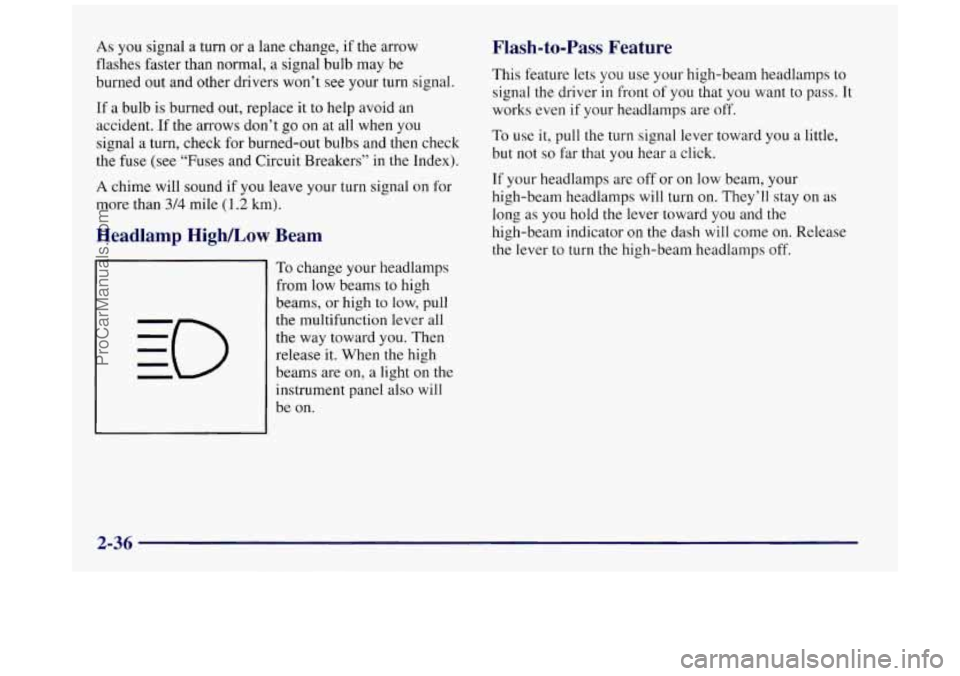
As you signal a turn or a lane change, if the arrow
flashes faster than normal, a signal bulb may be
burned out and other drivers won’t see your turn signal.
If a bulb is burned out, replace it to
help avoid an
accident. If the arrows don’t go on at all when you
signal a turn, check for burned-out bulbs and then check
the fuse (see “Fuses and Circuit Breakers” in the Index).
A chime will sound if you leave your turn signal on for
more than
3/4 mile (1.2 km).
Headlamp HigWLow Beam
To change your headlamps
from low beams to high
beams, or high to low, pull
the multifunction lever all
the way toward you. Then
release it. When the high
beams are on, a light on the
instrument panel also will
be on.
Flash-to-Pass Feature
This feature lets you use your high-beam headlamps to
signal
the driver in front of you that you want to pass. It
works even if your headlamps are off.
To use it, pull the turn signal lever toward you a little,
but not
so far that you hear a click.
If your headlamps are off or on low beam, your
high-beam headlamps will turn
on. They’ll stay on as
long as
you hold the lever toward you and the
high-beam indicator on the dash will come on. Release
the lever to turn
the high-beam headlamps off.
2-36
ProCarManuals.com
Page 114 of 422
The LOW WASH light
on your instrument panel
cluster will glow when the
fluid level
is low.
Cruise Control (Option)
In freezing weather, don’t use your washer until
the windshield
is warmed. Otherwise the washer
fluid can form ice on the windshield, blocking
25 mph (40 km/h) or more without keeping your foot
your vision. on the accelerator. This can really help on long trips.
Cruise control does not work at speeds below about
25 mph (40 km/h).
When you apply your brakes, the cruise control
shuts
off.
With cruise control, you can maintain a speed of about
ProCarManuals.com
Page 115 of 422
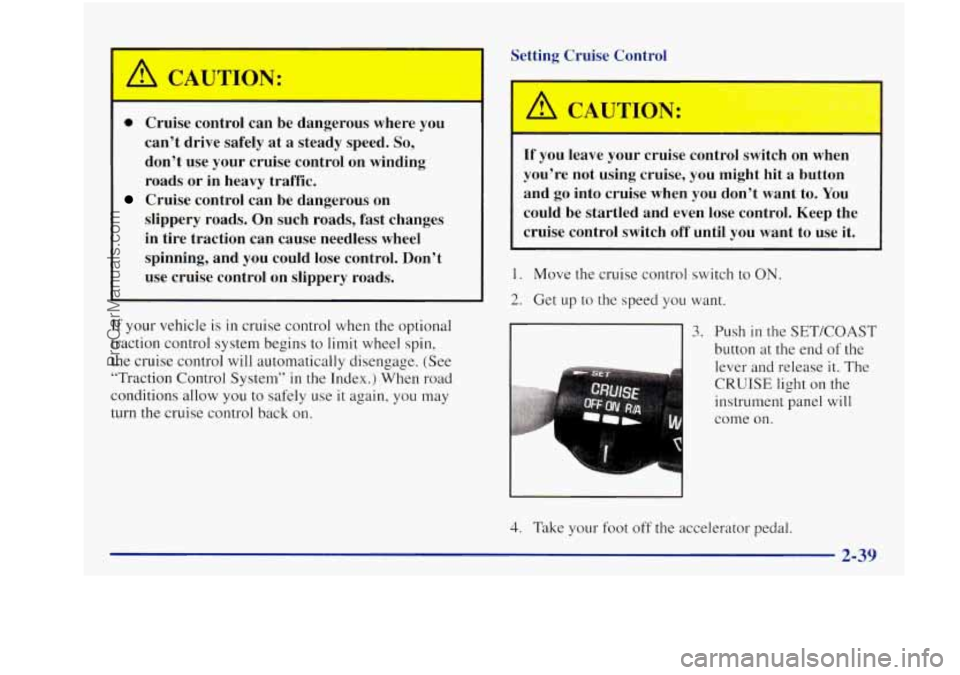
Setting Cruise Control
0 Cruise control can be dangerous where you
can’t drive safely at a steady speed.
So,
don’t use your cruise control on winding
roads
or in heavy traffic.
slippery roads. On such roads, fast changes
in tire traction can cause needless wheel
spinning, and you could lose control. Don’t
Cruise control can be dangerous on
If you leave your cruise control switch on when
you’re not using cruise,
you might hit a button
and go into cruise when you don’t want to. You
could be startled and even lose control. Keep the
cruise control switch off until you want to use it.
use cruise control on slippery roads.
1. Move the cruise control switch to ON.
2. Get up to the speed you want.
If your vehicle is in cruise control when the optional
traction control system begins to
limit wheel spin,
the cruise control will automatically disengage. (See
“Traction Control System’’
in the Index.) When road
conditions allow you to safely
use it again, you may
turn
the cruise control back on.
&I button at the end of the
lever and release it. The
CRUISE light on the
instrument panel will
come on.
3. Push in the SETKOAST
4. Take your foot off the accelerator pedal.
2-39
ProCarManuals.com
Page 117 of 422
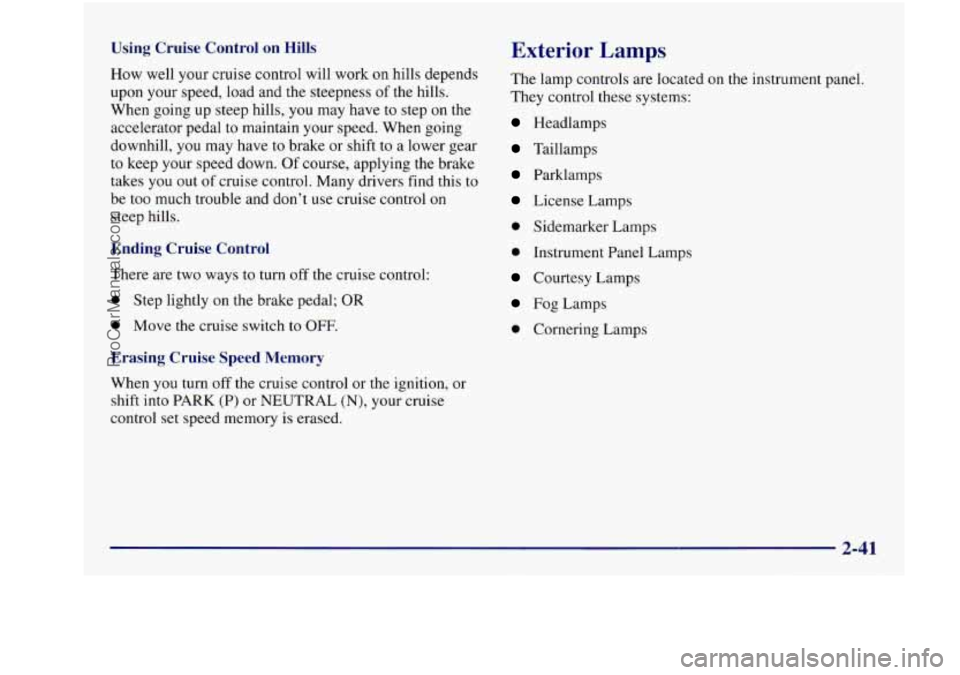
Using Cruise Control on Hills
How well your cruise control will work on hills depends
upon your speed, load and the steepness
of the hills.
When going up steep hills, you may have to step on the
accelerator pedal to maintain your speed. When going
downhill, you may have to brake or shift
to a lower gear
to keep your speed down.
Of course, applying the brake
takes
you out of cruise control. Many drivers find this to
be too much trouble and don’t use cruise control on
steep hills.
Ending Cruise Control
There are two ways to turn off the cruise control:
0 Step lightly on the brake pedal; OR
0 Move the cruise switch to OFF.
Erasing Cruise Speed Memory
When you turn off the cruise control or the ignition, or
shift into
PARK (P) or NEUTRAL (N), your cruise
control set speed memory is erased.
Exterior Lamps
The lamp controls are located on the instrument panel.
They control these systems:
Headlamps
Taillamps
Parklarnps
License Lamps
0 Sidemarker Lamps
0 Instrument Panel Lamps
Courtesy Lamps
Fog Lamps
0 Cornering Lamps
ProCarManuals.com
Page 118 of 422
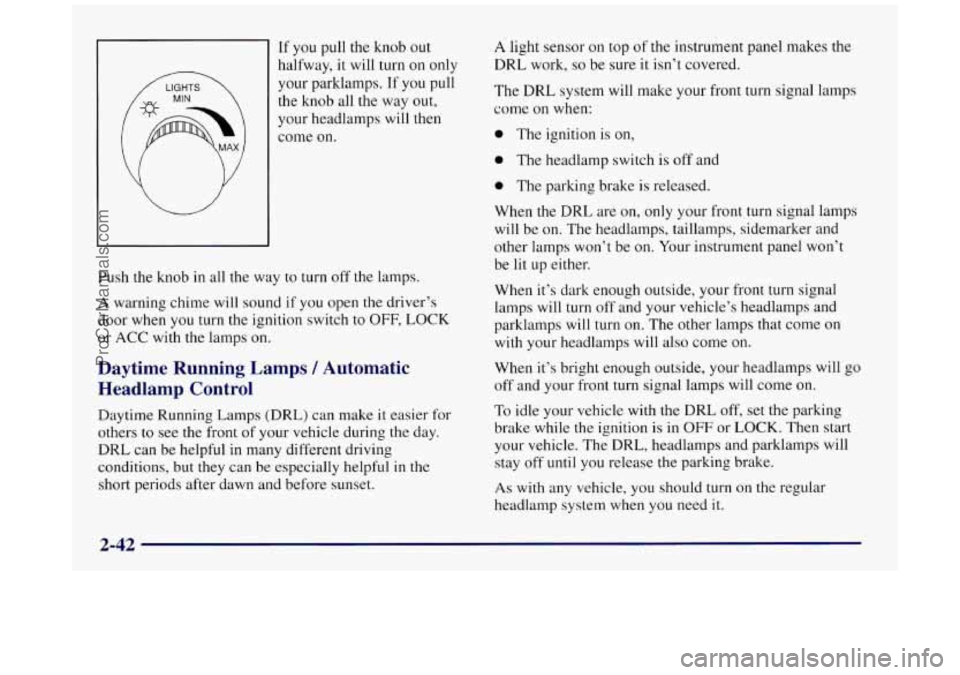
If you pull the knob out
halfway,
it will turn on only
your parklamps. If you pull
the knob all the way out,
your headlamps
will then
come on.
Push the knob
in all the way to turn off the lamps.
A warning chime will sound if you open the driver’s
door when you turn the ignition switch to
OFF, LOCK
or
ACC with the lamps on.
Daytime Running Lamps / Automatic
Headlamp Control
Daytime Running Lamps (DRL) can make it easier for
others to see the front
of your vehicle during the day.
DRL can be helpful in many different driving
conditions, but they can be especially helpful
in the
short periods after dawn and before sunset.
A light sensor on top of the instrument panel makes the
DRL work,
so be sure it isn’t covered.
The DRL system will make your front turn signal lamps
come on when:
0 The ignition is on,
0 The headlamp switch is off and
0 The parking brake is released.
When the DRL are on, only your front turn signal lamps
will be on. The headlamps, taillamps, sidemarker and
other lamps won’t be on. Your instrument panel won’t
be lit up either.
When it’s dark enough outside, your front turn signal
lamps will turn off and your vehicle’s headlamps and
parklamps will turn
on. The other lamps that come on
with your headlamps will also come on.
When it’s bright enough outside, your headlamps will
go
off and your front turn signal lamps will come on.
To idle your vehicle with the DRL off, set the parking
brake while
the ignition is in OFF or LOCK. Then start
your vehicle. The DRL, headlamps and parklamps will
stay off until you release the parking brake.
As with any vehicle, you should turn on the regular
headlamp system when you need
it.
2-42
ProCarManuals.com